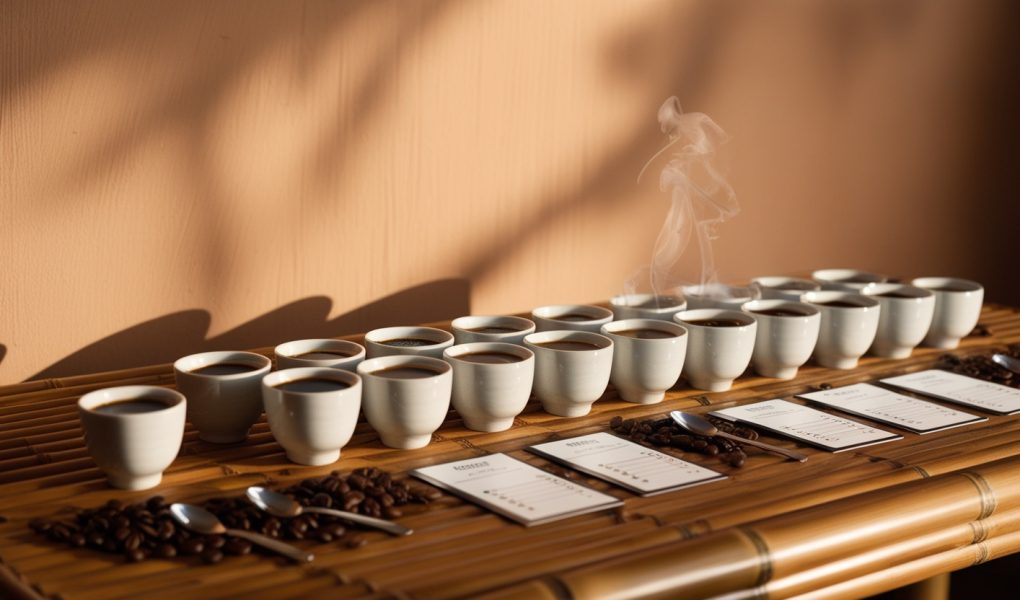Coffee cupping is an essential practice for coffee professionals and enthusiasts alike. This method allows you to explore the complexities of specialty coffee, from its aroma to the subtle flavor notes that define its character. More than just tasting, cupping is a structured approach to evaluating the quality of coffee beans, helping you appreciate their nuances. Whether you’re in the industry or simply passionate about coffee, mastering this technique deepens your understanding of what makes each coffee unique. This guide will walk you through the process step by step.
What You’ll Need for Cupping
To start your coffee cupping experience, you’ll need a few essential tools.
- Cupping bowls are key—preferably shallow and wide, as they allow the coffee to cool evenly for tasting.
- A grinder is crucial to get fresh, coarse-ground coffee, ensuring consistent flavor extraction.
- You’ll also need a scale to measure the correct amount of coffee per cup and cupping spoons for tasting, with a deep curve to help capture the liquid. Finally, have clean, fresh water for brewing and rinsing between tastes.
Step-by-Step Cupping Process
- Grind the Coffee: Start by grinding the coffee beans to a coarse consistency, similar to sea salt. Use around 8-10 grams of coffee per cup.
- Add Hot Water: Pour freshly boiled water (around 200°F) over the grounds in each cupping bowl, making sure to saturate them evenly. Let the coffee steep for about 4 minutes.
- Break the Crust: After steeping, gently break the crust that forms on top using a spoon, releasing the coffee’s aroma.
- Skim the Top: Remove the remaining floating grounds with your spoon.
- Taste: Once cooled slightly, slurp the coffee using a cupping spoon, covering your palate to capture all the flavors.
Tasting and Evaluating the Coffee
Once the coffee has cooled slightly, it’s time to start tasting. Use the cupping spoon to slurp the coffee—the slurping motion helps to spread the liquid across your palate, allowing you to pick up the full range of flavors. As you taste, pay attention to several key elements: acidity, sweetness, body, and aftertaste. Acidity refers to the brightness or sharpness of the coffee, while sweetness adds balance. The body is the coffee’s weight on your tongue, and the aftertaste lingers after each sip, giving a lasting impression.
As you taste, compare how different coffees express these characteristics. Some coffees may have fruity acidity, while others may offer a heavier body with chocolatey notes. Take notes on what stands out, as these details help you evaluate the coffee’s overall quality and complexity.
Understanding Coffee Characteristics
When cupping coffee, each bean reveals distinct characteristics shaped by its origin, processing method, and roast. Acidity gives the coffee its brightness—coffees from regions like Ethiopia often exhibit vibrant, fruity acidity, while those from Central America might lean toward a balanced citrus profile. Body refers to the weight or texture of the coffee on your palate; some coffees have a light, tea-like body, while others feel rich and full. Understanding these traits helps you evaluate the overall quality, distinguishing between subtle floral notes or bolder chocolate undertones.
Tips for Improving Your Coffee Palate
Refining your coffee palate takes practice and an open mind. Start by tasting a wide variety of coffees from different regions, roasts, and processing methods. Focus on identifying key flavors such as fruitiness, nuttiness, or floral notes in lighter roasts, and chocolate or caramel in darker ones. Keep a tasting journal to note how each coffee differs. Smelling and tasting other foods—like citrus, berries, or spices—can also help you recognize similar flavors in coffee. The more you expose your palate to, the sharper your tasting skills will become.
Conclusion
Mastering coffee cupping opens up a deeper appreciation for the complexity and nuances that specialty coffee offers. It’s not just about tasting—it’s about understanding the journey of the beans from origin to cup. With regular practice, you’ll refine your palate, learning to identify the subtle flavors and aromas that make each coffee unique. Whether you’re a coffee enthusiast or professional, cupping is an enjoyable way to connect with coffee on a deeper level. Keep experimenting, and you’ll continue to grow in your coffee-tasting journey.



